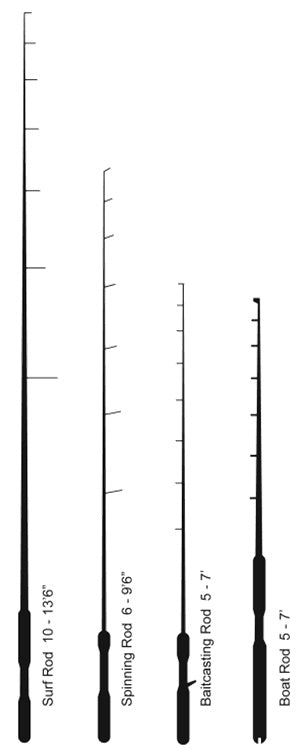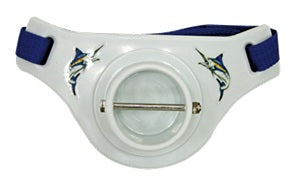Merry Christmas! 🎄Our warehouse will be closed over the Christmas New Year period from 17th Dec reopening 5th Jan. No orders will be shipped during this period.
Rod Construction

Over the years the angling public have demanded lighter and more responsive rods. Tubular steel was used for a while, but proved to be rather stiff and awkward. The invention of glass fibre helped dramatically to reduce the cost of manufacturing rods, but as they were solid affairs, they still proved to be too heavy. Companies then began to produce hollow glass fibre rods. It seemed the aim of producing light, strong and responsive rods had been met. Still we were not content.
During the late 1970’s, graphite made an appearance. A combination of glass fibre, carbon and resin, this again improved the rods performance and it wasn’t long before pure graphite rods started to appear. This material has become the standard for rod production ever since.
Rods are now longer, lighter and stiffer than ever, but still manage to maintain their responsiveness.
Different rods are built to suit different types of fishing.
Surf rods are long and strong to cast long distances, keep the line above the waves and fight large fish in surging swells.
Game rods are short and strong to lever large fish towards the boat.
While rods for spinning light lures for Bream and Bass are light and relatively stiff, with a springy tip for flicking the lure and setting the hook.
Baitcast rods are shorter with guides on top, as the reel is located on top of the rod. The guides are generally smaller because the line runs straight off the reel and there are more guides to ensure the line does not touch the rod when bent under the weight of a fish. Baitcast rods are generally shorter and designed for accurate casting.
Rod Taper
Rods come with different tapers.
A slow taper, or slow action (through action), means that the rod bends throughout its length. Slow action rods are popular for bait fishing allowing the fish to pick up the bait and swim off without feeling the resistance that a stiffer rod would produce. The angler simply allows the rod to bend over and then lifts the tip to set the hook.
A fast taper or fast action (tip action), means that the rod is stiffer, with the bulk of the bend being confined to the tip of the rod. Fast taper rods are generally preferred for lure casting. They will cast a lure further and bites can be better detected and hooks set more quickly. When using lures this bite detection and quick hook set are essential because once the fish realises the lure is not real food they will quickly reject it.
Rod Blanks
Modern rod blanks (the blank is the rod in its initial form without any guides, reel seat or grips) are made from one, or a combination, of the following three materials:
Glass Fibre – Glass fibre is more flexible and ideal for the construction of rods designed for bait fishing. The durability of fibreglass also makes it ideal for rods that will be used in harsh environments that may take a few knocks, such as beach and offshore fishing. The disadvantage of fibreglass is that it is heavier than graphite.
Graphite Composite – This is a slightly misleading term as the majority of material used is Glass Fibre. A small amount of graphite is used to reduce the weight, and the two materials are bonded together using resin. The quality of this composite material varies from cheaper through to better quality rods. Many game rods still feature a large percentage of fibreglass because, even though this makes them heavier, it makes them more durable.
Graphite – Graphite material is brittle by nature but is mixed with resin to provide strength and flexibility when constructing rods. Graphite rods are more lightweight, responsive and transfer information, such as bites and structure, much more effectively than fibreglass and composite materials.
There are varying qualities of graphite available and this is reflected in the price points of graphite rods on the market. As well as the quality of graphite, the quality of the other components including reel seats, grips and guides also dictate the price of the finished product.
Handle Materials

Handles are made of cork, EVA or a combination of both. Cork grips are lighter and more sensitive, transferring information more effectively to the angler. Cork grips are favoured by those fishing light lures and plastics because they provide more feel when working lures and better detect the often subtle bites of fish.
Higher end rods are now appearing on the market using new generation EVA foam grips that have been designed to be more lightweight and transfer information more effectively than traditional grips.
Both can be cleaned with warm water. If a cork handle becomes very dirty, using fine sandpaper can bring it up like new.
Reel Seats allow the angler to simply and securely attach the reel onto the fishing rod. The quality of the reel seat will vary from budget rods through to the top end models.
Guides / Runners
There are a range of guides available and the quality of guides used on a rod can also influence its price. Higher end guides are constructed from materials that may be more lightweight, resistant to saltwater, stronger and may better transfer heat away from the line when travelling through the guides.
Roller Guides
Roller guides are designed for use on game fishing rods. The rollers built into the guide reduce the friction of the fishing line running through minimising friction on the line.
As the quality of guides has improved it has become less necessary to use roller guides. Roller guides often now only appear on the heavier end of game rods, including the 37kg class.
Gimbles and Gimble Belts

A gimble fitting is the section on the butt of a rod that allows it to be locked into a gimble belt. They are commonly used on game rods for fighting larger fish. The gimble locks onto the pin in the gimble belt and stops the overhead rod from twisting when under load. The gimble belt also protects the angler by supporting the rod and stopping the butt of the rod from digging into the angler.
Rod Maintenance
Many anglers forget to take a quick look at their fishing rods for hints of wear. There are several easy maintenance steps to keep fishing rods looking and performing at their best. These include:
- Pull a strip of nylon stocking through each guide. If the material sticks or threads, there’s probably a nick in the guide which could lead to line damage. Replace the guides as necessary.
- Inspect guide whipping for hints of wear. Re-whip if necessary.
- Clean the rod grips by gently washing with warm water and detergent solution. If fish scales and slime prove stubborn, gently scrub the grips with a tooth brush or something similar.
- Check the reel seat for any build-up of salt or soiling residue, or evidence of corrosion. This is common when the reel is used regularly in a saltwater environment. The reel will not sit properly in the reel seat with any build-up on the seat, and the seat may be difficult to move or could even seize up if corroded. This can be remedied by rubbing with a soapy sponge, rinsing with cool water and drying thoroughly with a towel.
- If utilizing a two-piece rod, rub a very light coating of paraffin onto the join. This not only makes for a firm, secure connection, but also makes it easier to separate the sections.
- Store the rod(s) in a horizontal or vertical rack as opposed to leaning against a wall or stacking in a comer where the rod might bend and actually take a “set”.
- Run your fingers over the length of the blank. Should you detect any dings, the rod may have incurred damage that may cause it to break during use.
The evolution of fishing rods has come a long way to meet the demands of anglers who require lightweight, responsive and strong rods. From the use of tubular steel to the invention of glass fiber and now graphite, the materials used in rod construction have greatly improved over the years. Different types of fishing require specific types of rods such as surf rods, game rods, spinning rods, and baitcast rods, each with unique features to suit their purpose. It is important to note that the quality of the materials and components used in the construction of the rod, such as the handle materials, reel seats, and guides, all play a crucial role in the overall performance of the rod.
Proper maintenance of the rod is also essential to keep it in top condition for longer. With the information provided on rod construction, anglers can make informed decisions and choose the right rod for their fishing needs. So, whether you are an experienced angler or a beginner, it is time to upgrade your rod to the latest technology for a better fishing experience.

Leave a comment: